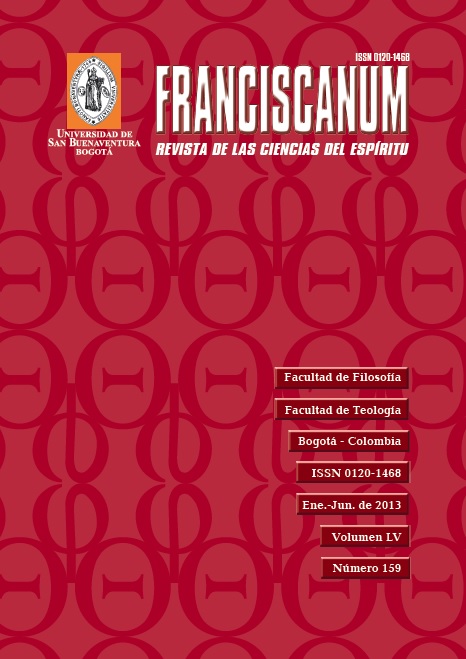This journal provides immediate open access to its content, based on the principle that giving the public free access to research helps a greater global exchange of knowledge.
Therefore, the Creative Commons 4.0 Attribution Attribution - Equal Share (by-sa) License is accepted: The commercial use of the work and the possible derived works is permitted, the distribution of which must be done with a license equal to that regulates the original work.
http://creativecommons.org/licenses/by-sa/4.0/
Along these same lines and in line with the Open Access policy, it is clarified that the authors maintain their rights to articles, without restrictions and, in the same way, they maintain their publication rights, without restrictions. They are only asked to reference the number of the Franciscanum magazine where the article initially appeared.
Abstract
Keywords:
References
Barnavi, Élie. Las religiones asesinas. Madrid: Turner, 2007.
Broese, Konstantin et ál. (Hrsg.). Die Deutung der Welt. Jörg Salaquardas Schriften zu Arthur Schopenhauer. Würzburg: Verlag Königshausen & Neumann GmbH, 2007.
Huntington, Samuel P. El choque de civilizaciones y la reconfiguración del orden mundial. Barcelona: Paidós, 2005.
Kant, Inmanuel. Crítica de la razón pura. Madrid: Alfaguara, 1978.
Kruck, Günter. «Zur Rationalität der Religion. Schopenhauer und sein Verhältnis zu einem neuen Strang von Religionsphilosophie», Jahrbuch der Schopenhauer-Gesellschaft (2010): 121-134.
Maceiras Fafián, Manuel. «La Voluntad como energía», Logos. Anales del Seminario de Metafísica 23 (1989): 119-134.
Magee, Bryan. Schopenhauer. Madrid: Cátedra, 1991.
Mannion, Gerard. Schopenhauer, Religion and Morality. The Humble Path to Ethics. England: Ashgate Publishing Limited, 2003.
Nietzsche, Friedrich. El nacimiento de la tragedia. Madrid: Alianza, 1991.
________. Sobre la utilidad y el perjuicio de la historia para la vida [II Intempestiva]. Madrid: Biblioteca Nueva, 1999.
________. Schopenhauer como educador. Madrid: Biblioteca Nueva, 2000.
________. La genealogía de la moral. Madrid: Alianza, 1987.
________. Ecce homo. Madrid: Alianza, 1987.
________. Crepúsculo de los ídolos. Madrid: Alianza, 1993. Platón, El banquete. Madrid: Alianza, 2005.
Ruiz Callejón, Encarnación. «La ‘tercera navegación’ en Schopenhauer: el carácter adquirido y el arte de vivir». Daimon. Revista de Filosofía 31 (2004), pp. 23-42.
________. Nietzsche y la filosofía práctica. La moral aristocrática como búsqueda de la salud. Editorial Universidad de Granada, 2004.
________.«El concepto de ‘conciencia mejor’ en Schopenhauer», Pensamiento. Revista de investigación e información filosófica 63 (2007): 437-462.
Ryan, Christopher. Schopenhauer’s Philosophy of Religion. The Death of God and the Oriental Renaissance. Leuven: Peeters, 2010.
Safranski, Rüdiger. Schopenhauer y los años salvajes de la filosofía. Madrid: Alianza, 1991.
Schmidt, Alfred. Die Wahrheit im Gewande der Luge:
Schopenhauers Religionsphilosophie. Múnich, Zúrich: Piper, 1986.
Schopenhauer, Arthur. Werke in zehn Bänden. Zürich: Diogenes Verlag, 1977.
________. Der handschriftliche Nachlass in fünf Bänden. München: Deutscher Taschenbuch Verlag, 1985.
________. El mundo como voluntad y representación. Madrid: Trotta, 2004.
________. El mundo como voluntad y representación. Complementos. Madrid: Trotta, 2003.
________. Los dos problemas fundamentales de la ética. «Sobre el fundamento de la moral». Madrid: Siglo xxi, 1993.
________. Parerga y Paralipómena I. Madrid: Trotta, 2006.
________. Parerga y Paralipómena II. Madrid: Trotta, 2009.
________. Parerga y paralipomena. Tomo primo. Milano: Adelphi Edizioni, 1981.
________. Escritos inéditos de juventud (1808-1818). Sentencias y aforismos II. Valencia: Pre-Textos, 1999.
________. El dolor del mundo y el consuelo de la religión (Paralipomena 134-182). Madrid: Alderabán, 1998.
________. Manuscritos berlineses. Sentencias y aforismos (Antología). Valencia: Pre-Textos, 1996.
________. Epistolario de Weimar (1806-1819). Selección de cartas de Johanna, Arthur Schopenhauer y Goethe. Madrid: Valdemar, 1999.
________. Senilia. Reflexiones de un anciano. Barcelona: Herder, 2010.
Wallace, William. Arthur Schopenhauer. Barcelona: Ediciones de Nuevo Arte Thor, 1988.
Wilhelm, Karl W. Zwischen Allwissenheitslehre und Verzweiflung: der Ort der Religion in der Philosophie Schopenhauers. Hildesheim; New York: G. Olms, 1994.
Zimmer, Robert. Arthur Schopenhauer. Ein philosophischer Weltbürger. München: Deutscher Taschenbuch Verlag, 2010.



















